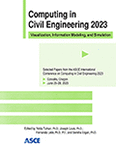A Dynamic Agent-Based Optimization Model for Green Infrastructure to Address Flooding Risks
Publication: Computing in Civil Engineering 2023
ABSTRACT
Green infrastructure (GI) helps manage localized and riverine floods by reducing stormwater runoff and protecting floodplains. GI practices that reduce flooding risks and enhance infiltration include permeable pavements (PPs), rain gardens, and bioswales, among others. PPs are among the frequently used GIs for stormwater management and mitigation of flood risk because they allow more rainfall to soak into the ground and can be easily used in urban areas (i.e., in parking lots and roadway shoulders). While previous research on PPs focused on their benefits and engineering properties, little-to-no studies were conducted to optimize their maintenance practices. Hence, this paper aims at filling this knowledge gap. First, the maintenance, repair, and replacement process of PPs was modeled. Second, an agent-based simulation was developed to model the maintenance-related considerations of PPs. Third, an optimization module was integrated into the developed agent-based model to determine optimal maintenance strategies. The developed agent-based optimization model was applied to New York City’s network of PPs to help the city optimize the maintenance of its GI assets by minimizing the total incurred cost of maintenance operations. The findings indicated that the optimal strategy includes 13 service teams, a replacement policy, and 12 maintenance periods after which replacement is required. This study adds to the body of knowledge by proposing a dynamic agent-based model that could be used to improve the functionality and lifespan of PPs, which would ultimately assist in reducing flooding and help communities implement optimal GI strategies.
Get full access to this article
View all available purchase options and get full access to this chapter.
REFERENCES
Assaad, R. H., Assaf, G., and Boufadel, M. (2023). Optimizing the maintenance strategies for a network of green infrastructure: An agent-based model for stormwater detention basins. Journal of Environmental Management, 330, 117179.
Boogaard, F., Lucke, T., van de Giesen, N., and van de Ven, F. (2014). Evaluating the Infiltration Performance of Eight Dutch Permeable Pavements Using a New Full-Scale Infiltration Testing Method. Water, 6(7), 2070–2083.
Dhakal, K. P., and Chevalier, L. R. (2017). Managing urban stormwater for urban sustainability: Barriers and policy solutions for green infrastructure application. Journal of Environmental Management, 203, 171–181.
Dierkes, C., Kuhlmann, L., Kandasamy, J., and Angelis, G. (2002). Pollution Retention Capability and Maintenance of Permeable Pavements. Global Solutions for Urban Drainage, 1–13.
Drake, J., and Bradford, A. (2013). Assessing the potential for restoration of surface permeability for permeable pavements through maintenance. Water Science and Technology, 68(9), 1950–1958.
Du, J., Qian, L., Rui, H., Zuo, T., Zheng, D., Xu, Y., and Xu, C.-Y. (2012). Assessing the effects of urbanization on annual runoff and flood events using an integrated hydrological modeling system for Qinhuai River basin, China. Journal of Hydrology, 464–465, 127–139.
Ghaderi, M. (2022). Public health interventions in the face of pandemics: Network structure, social distancing, and heterogeneity. European Journal of Operational Research, 298(3), 1016–1031.
Jezzini, Y., Assaf, G., and Assaad, R. H. (2023). Models and Methods for Quantifying the Environmental, Economic, and Social Benefits and Challenges of Green Infrastructure: A Critical Review. Sustainability 2023, 15, 7544.
Mei, C., Liu, J., Wang, H., Yang, Z., Ding, X., and Shao, W. (2018). Integrated assessments of green infrastructure for flood mitigation to support robust decision-making for sponge city construction in an urbanized watershed. Science of The Total Environment, 639, 1394–1407.
Mullaney, J., and Lucke, T. (2014). Practical Review of Pervious Pavement Designs. CLEAN - Soil, Air, Water, 42(2), 111–124.
NYC DEP (The City of New York Department of Environmental Protection). (2016). Green Infrastructure Performance Metrics Report The City of New York Department of Environmental Protection. <https://www1.nyc.gov/assets/dep/downloads/pdf/water/stormwater/green-infrastructure/gi-performance-metrics-report-2016.pdf>(Jan. 13, 2023).
Radfar, A. (2015). Artifical neural network models for the analysis of permeable pavement performance. [University of Louisville].
Radfar, A., and Rockaway, T. D. (2016). Clogging Prediction of Permeable Pavement. Journal of Irrigation and Drainage Engineering, 142(4).
Sanicola, O., Lucke, T., and Devine, J. (2018). Using permeable pavements to reduce the environmental impacts of urbanisation. International Journal of GEOMATE, 14(41), 159–166.
Scholz, M., and Grabowiecki, P. (2007). Review of permeable pavement systems. Building and Environment, 42(11), 3830–3836.
Smith, E. R., and Conrey, F. R. (2007). Agent-Based Modeling: A New Approach for Theory Building in Social Psychology. Personality and Social Psychology Review, 11(1), 87–104.
Tracy, M., Cerdá, M., and Keyes, K. M. (2018). Agent-Based Modeling in Public Health: Current Applications and Future Directions. Annual Review of Public Health, 39(1), 77–94.
Wang, Y., Li, H., Abdelhady, A., and Harvey, J. (2018). Initial evaluation methodology and case studies for life cycle impact of permeability of permeable pavements. International Journal of Transportation Science and Technology, 7(3), 169–178.
Winston, R. J., Al-Rubaei, A. M., Blecken, G. T., and Hunt, W. F. (2016). A Simple Infiltration Test for Determination of Permeable Pavement Maintenance Needs. Journal of Environmental Engineering, 142(10).
Zhang, Z., Xue, J., Zhang, J., Yang, M., Meng, B., Tan, Y., and Ren, S. (2021). A deep learning automatic classification method for clogging pervious pavement. Construction and Building Materials, 309, 125195.
Information & Authors
Information
Published In
History
Published online: Jan 25, 2024
ASCE Technical Topics:
- Architectural engineering
- Building management
- Business management
- Disaster risk management
- Dynamic models
- Engineering fundamentals
- Environmental engineering
- Floods
- Infrastructure
- Infrastructure vulnerability
- Maintenance and operation
- Models (by type)
- Optimization models
- Practice and Profession
- Risk management
- Stormwater management
- Sustainable development
- Water and water resources
- Water treatment
Authors
Metrics & Citations
Metrics
Citations
Download citation
If you have the appropriate software installed, you can download article citation data to the citation manager of your choice. Simply select your manager software from the list below and click Download.
